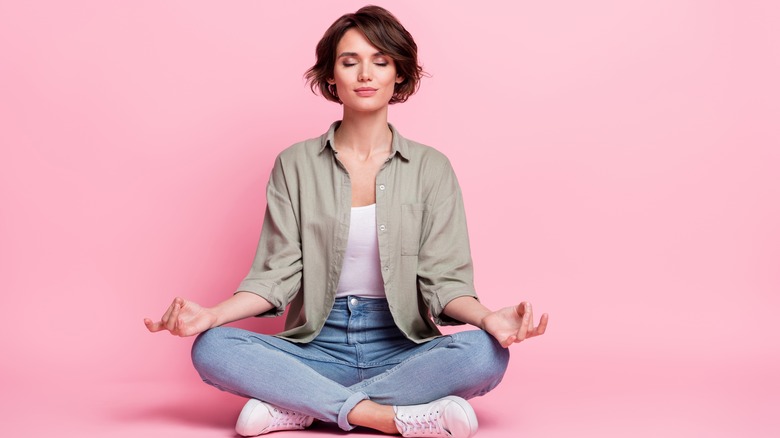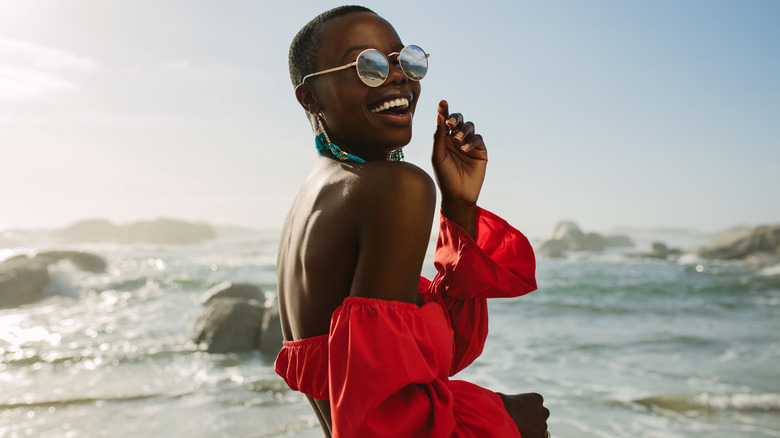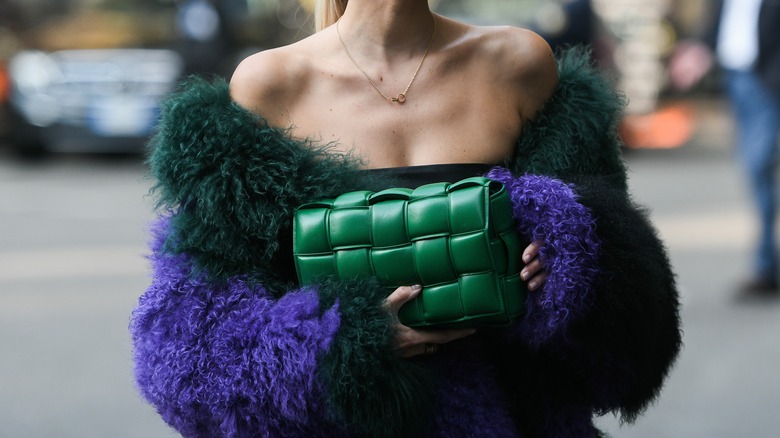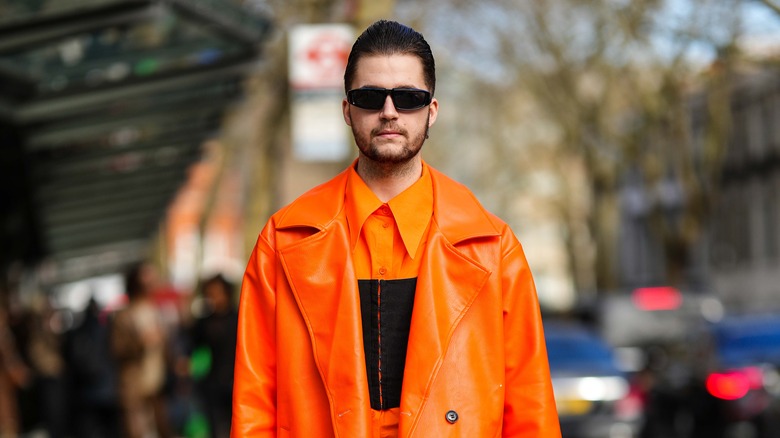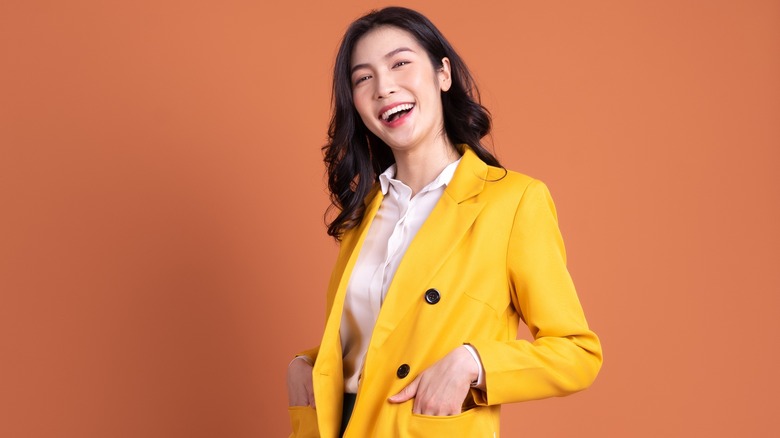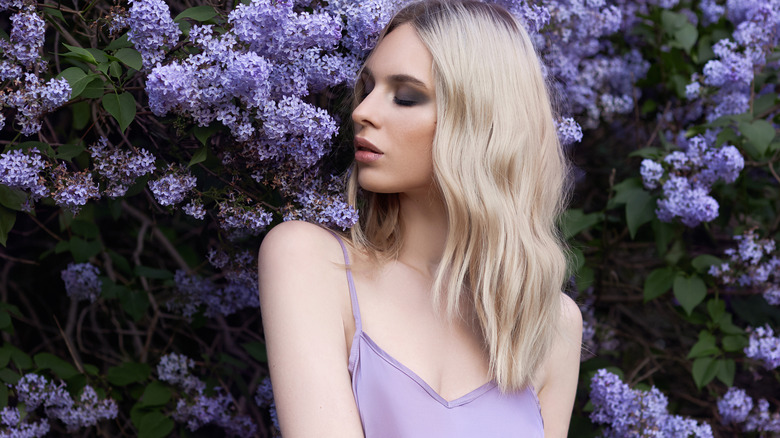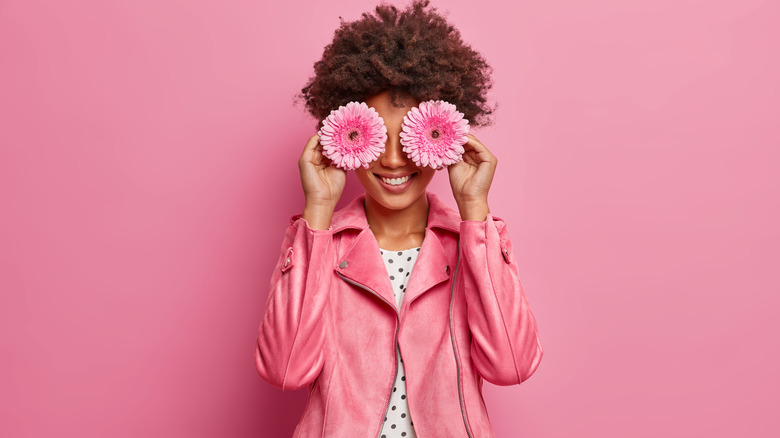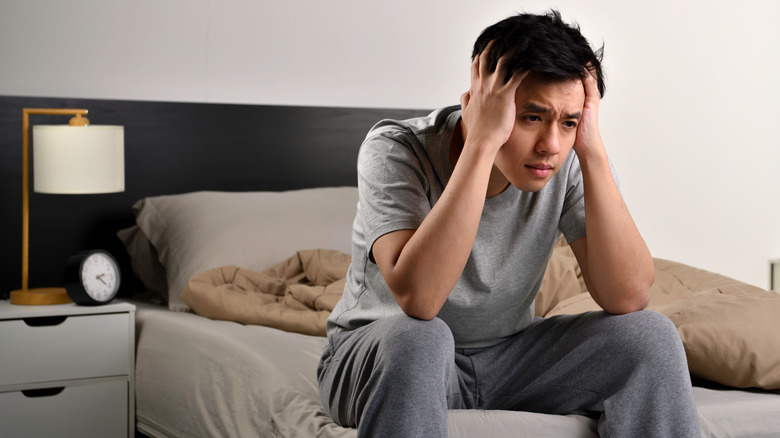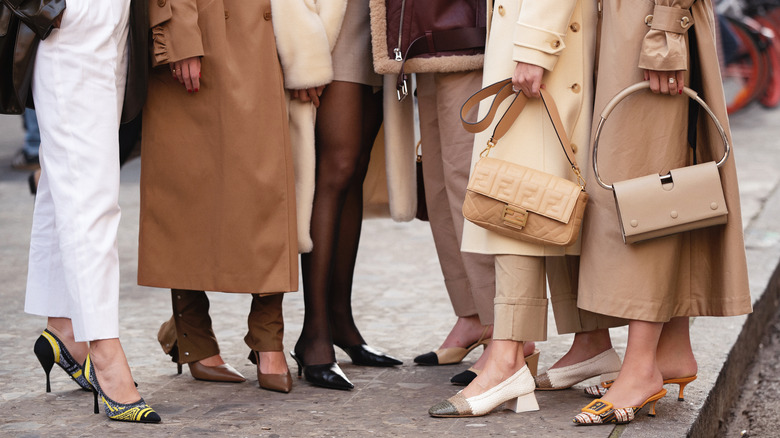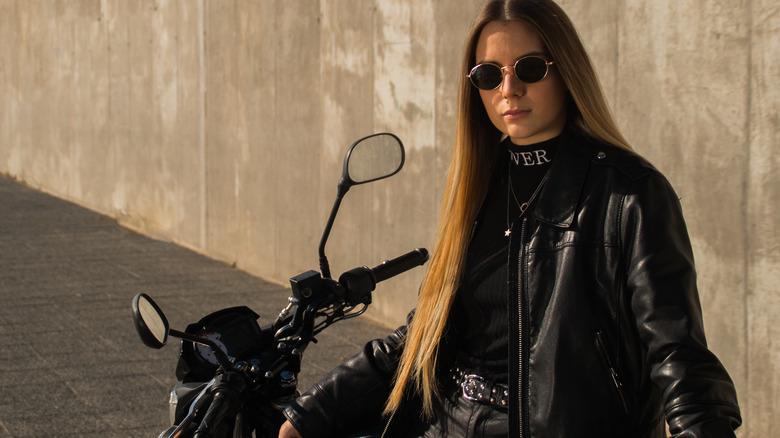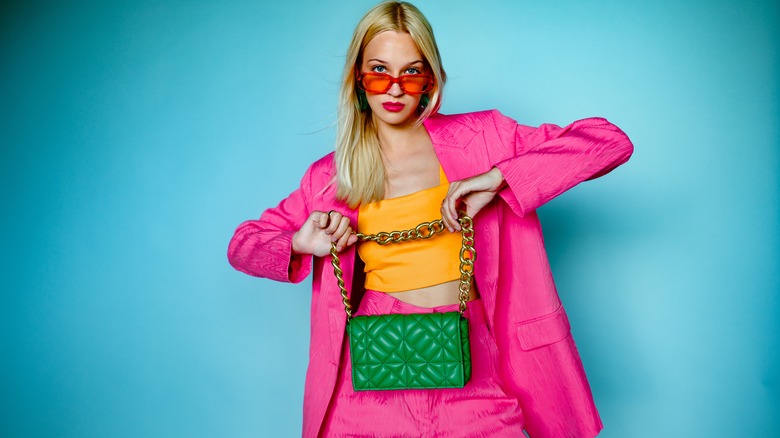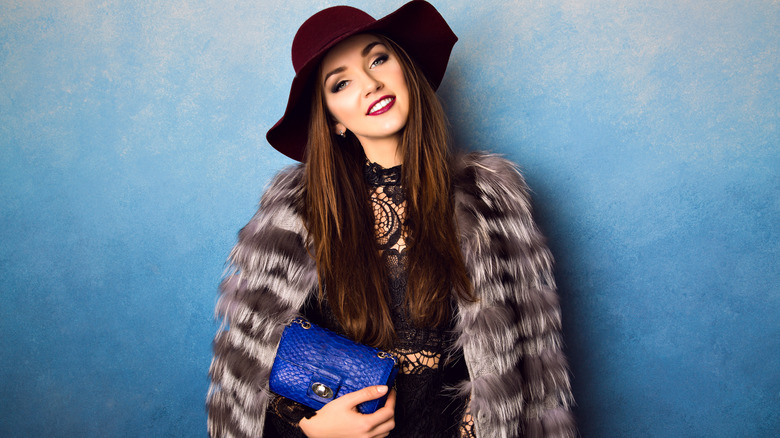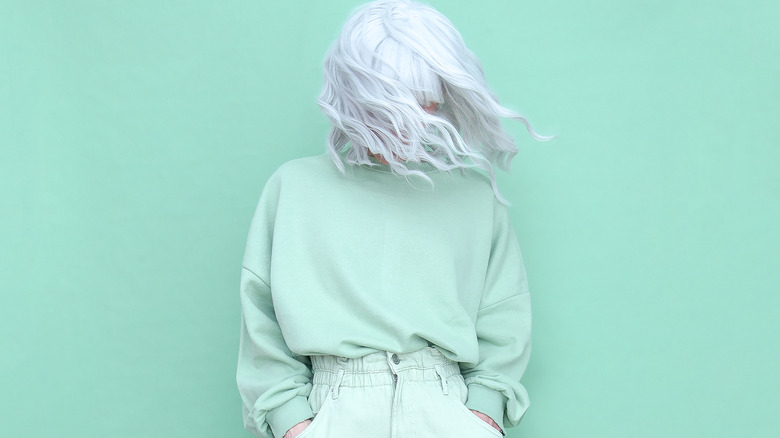How Others Perceive You According To The Colors You Wear
All of us have favorite colors. But not all of us realize that wearing the colors we love can actually have a profound impact on how we feel — and how others perceive us. Beyond the well-known concepts of red as a sexy, date night color and white as a pure and innocent color, all of the colors have various meanings and associations, thanks to color psychology, which posits that different colors can affect human emotions and behaviors.
You can even use color to improve your day-to-day life. According to psychologist Bethany Cook, you can learn which colors make you feel best, and then use them to help you tackle whatever your day may have in store. "Look at drawings, go to an art museum, and immerse yourself in colors. Go to a store and try on a variety of colors, picking ones you wouldn't normally choose. Look in the mirror and see how you feel in each look," Cook suggests (per Real Simple). "Once you have an awareness of your own bias for colors, ask yourself what you 'need' for the day when you wake in the morning: strength, calm, patience, or energy. From there, choose your outfit according to the colors that represent those feelings."
Below, we'll fill you in on what each of the colors represents and how others may perceive you based on which colors you wear most often.
Blue
Blue is a calming color that we associate with the sky, the ocean, mountains, and other sources of tranquility, and it makes sense that wearing the color can give you a general air of serenity. There's also the fact that blue is a lot of people's favorite color — according to House Beautiful, 29% of people in the United States report blue as their number-one fave.
Aside from the fact that blue is calming and a fan-favorite, it may also give you an advantage next time you're going to a job interview. A study by CareerBuilder revealed that about a quarter of hirers prefer job candidates to wear blue at their interview. Of course, there are colors you should avoid at interviews, too. Overall, blue is a color that makes you appear calm, put-together, and approachable, and is appropriate for just about any occasion. It's also a good choice if you find yourself appearing before a judge — while you may think blacks and dark grays are appropriate for the courtroom, these colors can appear dark and secretive. Navy gives off a serious vibe while still conveying a sense of trustworthiness.
Red
Most of us associate red with love and passion — there's a reason that Valentine's Day decor and packaging are always in shades of red and pink. Studies show that red is also associated with fertility and desirability, so wearing this saturated hue may make you appear more attractive to potential suitors.
But red is also known as the most "intense" color — it can indicate urgency, which is why stop signs are red, as well as "order now" buttons and other marketing tools that aim for consumers to act fast. Red can also indicate aggression. According to Jennifer Hettema, senior clinical director at LifeStance Health, "In both animals and humans, red can indicate the release of hormones associated with aggression and serve as a signal of dominance to others. In fact, many studies have documented a 'red effect' whereby athletes or teams that wear red seem to have a slight advantage when compared to other colors" (via Real Simple).
So, while red can make you seem confident and powerful — making it a good choice for a date, for a day when you need a boost of confidence, or even a wedding — it may give off the wrong impression if it's worn in a serious or professional setting. With that said, different tones of red can create different impressions, so don't be afraid to wear that pop of color.
Green
When we think about the color green, most of us will probably think about nature. Trees, grass, and plants all come in various shades of green, both vibrant and muted. And along those lines, nature tends to make us think of peace, calm, and tranquility. Not so coincidentally, these terms are also associated with the psychology of the color green, per Oberlo.
In addition to invoking the peacefulness of nature, green can also represent healing, success, and hope. If you're someone who wears a lot of green, it's likely that people see you as a person who is down-to-earth, friendly, and balanced. Green is also a favorite with design bloggers, so that also wins you some brownie points (per House Beautiful). And if you happen to be someone who likes green, but doesn't quite know how to wear it? Take stylist Emili Sindlev's advice, who told Who What Wear that anyone who wants to incorporate a new color into their wardrobe should "start with colorful accessories and then when you are ready, jump into full outfits."
Orange
If you're someone who wears a lot of orange, people likely see you as someone who is outgoing, upbeat, and optimistic. This is because the color is associated with cheerfulness and energy. However, wearing orange may also give people the impression that you're arrogant. According to the Perception of Color study, people view orange as the second-most arrogant color, right behind red.
And if you were considering wearing orange to that job interview or a first date, it's time to reconsider your options. While you may be thinking that orange is close to red, and red is always a good choice for a first date, this is unfortunately not true. According to the same Perception of Color study, orange was the least preferred color for a first date, with only 2% of women opting to wear orange on a first date and just 6% of men going for orange on the first date.
And as for that job interview ... well, the study showed that orange is not a color that people tend to associate with intelligence, making it a bad choice for an interview.
Yellow
If your favorite color to wear is yellow, congratulations! You are unique. According to Apartment Therapy, yellow is an underappreciated color, with only 5% of people preferring this warm and sunny hue. It's a bit surprising that this color is so unpopular since it denotes positive things like warmth, happiness, and youth. On top of that, psychologists suggest that yellow can even boost your mood: "Yellow is a color that many people fear wearing, but psychologically it's linked to confidence, happiness, self-esteem, and optimism," says expert Karen Haller (via Good Housekeeping).
If you're a fan of wearing yellow, people likely see you as a bubbly and positive person who's willing to go a little outside the box. However, one thing to be aware of if you wear a lot of yellows is that the Perception of Color study found that people tend to view yellow as one of the less "intelligent" colors, along with pink and orange.
Purple
Because purple is a mix of red and blue, the color is associated with aspects of both of the colors' meanings. While red is associated with passion, power, and aggression, blue is associated with calmness, inspiration, and intuition. Combining these two colors — with very different color psychologies — results in purple, a color that is associated with royalty, wisdom, and spirituality (per Color Psychology).
Purple is often reserved for those who are linked to power and dignity. According to Color Psychology, "Just as history depicts the most influential royals wearing purple robes, so too has it been used for public officials, honored military veterans, so on and so forth. Purple represents independence and grace, and as such should be used accordingly."
Purple also has ties to magic and mysticism, according to Color Psychology. So if you tend to wear purple frequently, the people around you likely see you as someone who is wise, dignified, and maybe a bit mysterious.
Pink
Pink is a divisive color, and people tend to love or hate it. In color psychology, pink is linked to playfulness and femininity ... and it's also a color that masculine folks are known to avoid like the plague. More than any other color, pink is a highly gendered color — associated with everything from tampons to lipstick — and we're guessing that if it's your favorite color to wear, you're probably a more feminine person. If you wear a lot of pink, others may see you as ultra-feminine, youthful, and nurturing.
Because pink is also known as a relaxing color, it has actually been used as a tool to reduce aggression. In the 1960s, scientist Alexander Schauss noticed that looking at a bright pink tone lowered his blood pressure and heart rate. He deduced that the color may have the ability to reduce aggression and anger in inmates, and he was able to test this theory at the Seattle U.S. Naval Correctional Facility in 1979.
His hypothesis proved to be correct, and the pink walls were a "huge success" in reducing aggression among inmates, according to ATTN. If you've got a tense conversation or potentially volatile situation coming up, wearing pink might end up giving you an unexpected advantage.
Gray
Most people have at least a few gray clothing items in their closet, and it makes sense — it's a neutral color that matches with lots of other colors, and grays look good on different skin tones. It is generally an easy color to wear. Gray falls in between black and white, giving the impression of balance. And while gray may seem like a nice, versatile shade overall, there's some bad news: It can actually give off a negative impression compared to other colors.
This is because many people associate gray with sadness, passiveness, and a lack of energy, according to Science of People. Gray's absence of color makes it appear dull and drab. If you're someone who opts for gray, you may be panicking at this point, but have no fear! Pairing gray with other colors, like blue, which carries a peaceful and uplifting vibe, or yellow, which is known as a joyful color, can offset the potentially negative impressions that gray can give off.
And keep in mind that the color that you feel the best in is unique to you; if you feel most confident in gray, then there's a good chance you look best in gray too. Psychologist Bethany Cook explains this perfectly. "Our personal affinity for certain colors may be closely tied to our cultural and/or life experiences, so your experience may not fall into the typical norms of 'red makes me feel strong' and 'blue makes me feel calm," she told Real Simple.
Neutral colors
Neutral colors like white, beige, and brown can be safe options that look put-together without making too much of an impact. However, you may appear passive if you often opt for neutrals, particularly brown. According to style expert Carol Davidson, "Like every color, brown does have some positive attributes; it can read comforting and reliable. But ... it may give the impression you're staid and passive" (via Fast Company). The same goes for gray, which, due to its lack of color, can give the impression of dullness and passivity.
Though brown and gray shades may give a negative impression, white is a neutral color that you really can't go wrong with. It's associated with cleanliness, purity, innocence, and perfection — and it matches with everything, to boot. According to Davidson, white is also one of the best colors to wear in a professional setting. "Its 'immaculate' quality can suggest an attention to detail and therefore makes it a good choice for an interview," she said.
But don't immediately throw out all your gray and brown clothes — brown can be a grounding and practical choice, and some associate gray with logic and analytical thinking. Maybe just pair them with complimentary colors ... and wear them sparingly.
Black
Black is one of the most popular colors that people wear, and for good reason. It's versatile, matches well with other colors, and tends to look elegant and sophisticated. If you wear a lot of black, you likely give the impression of being mysterious, confident, strong, and a leader. Black is also known to be a good choice for first dates; according to the Perception of Color study, wearing black inspires confidence more than any other color for a first date, even surpassing red, which many find to be an alluring first-date color. The study also found that people see black as the color that makes a person look the most intelligent — and the sexiest.
Despite the popularity of the color, the psychology of the color black isn't all good, per Color Psychology. For example, black can denote evil, depression, and darkness, as well as sadness and mourning — there's a reason we customarily wear black to funerals. Color psychology aside, it's clear that black is a powerful color; it just may not provide a boost to your mood like the peppier colors of orange or yellow would.
Bright colors
If you prefer to dress in bright or neon colors, we commend you. It can be difficult to style in-your-face colors, but for the brave souls who pull it off, it looks amazing. Additionally, wearing bright colors is likely to make people see you as a more friendly and outgoing person compared to those who tend to stick with neutral colors; a study "found that subjects who were wearing or were surrounded by high-chroma colors were perceived as being more open and extroverted than when they were wearing or surrounded by low-chroma colors" (per Psychology Today).
On top of making you appear friendly and extroverted, wearing bright colors frequently is likely to have a positive impact on your own mood. A study (via Psychology Today) showed that bright and highly-saturated colors were more likely to increase heart rate — which can be associated with alertness and wakefulness — while gray caused a decrease in heart rate, which could be associated with sleepiness and boredom.
Jewel tones
Do you find yourself leaning toward rich tones like burgundy, forest green, sapphire, and mustard? If so, you probably have a preference for jewel tones, named precisely for their resemblance to precious stones like emeralds and rubies.
Due to their association with gems and their elegant, deeply saturated colors, jewel tones can all lend an air of luxury to anyone who wears them. Jewel tones can also add vibrancy in a more subtle way than wearing a bright or neon color. If you like jewel tones but aren't sure exactly how to incorporate them into your current wardrobe, Refinery29's senior style editor, Annie Georgia Greenberg, has some tips: "A good way to start trying out wearing jewel tones is to pair it with black and white." This could be in the form of an emerald-and-black striped skirt, as Greenberg showcases, or even an accessory in a jewel tone. Greenberg also suggests trying out jewel-toned makeup, like a garnet lipstick, or a jewel-toned necklace, like an emerald pendant or amber beads.
Pastel colors
You may associate pastel colors with babies, the freshest springtime, or Easter, but they're more than that — incorporating some light and bright pastel colors into your life can give peaceful and calming vibes. According to Color Psychology, pastels are achieved by mixing white with other colors, which results in shades of lower saturation, so they usually appear mellow, relaxing, and easy on the eyes.
On top of their relaxing and serene vibes, pastel colors are also very on-trend for 2023. According to InStyle, the fashion of the 2023 Golden Globes showed a slew of celebrities dressed in pastel shades, from Kaley Cuoco's soft lilac gown to Julia Garner's baby pink corset dress. For those of us who don't have any Golden Globes ceremonies coming up, incorporating pastel colors into our daily wardrobes may be just the thing to bring a little peace and balance into our lives.
